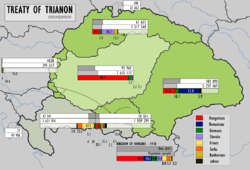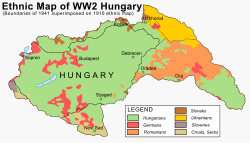Demographics of Hungary
The Demographics of Hungary is the study of the population and people in Hungary.
Population
Nation
| Census year |
Population | Change |
|---|---|---|
| 1949 | 9,204,799 | − |
| 1960 | 9,961,044 | +8.22% |
| 1970 | 10,322,099 | +3.62% |
| 1980 | 10,709,463 | +3.75% |
| 1990 | 10,374,823 | −3.12% |
| 2001 | 10,198,315 | −1.70% |
| 2011 | 9,937,628 | −2.56% |
Cities and towns
| Rank | City | County | 2011 census | 2020 estimate | Change |
|---|---|---|---|---|---|
| 1 | Budapest | Budapest | 1,733,685 | 1,750,216 | +0.95% |
| 2 | Debrecen | Hajdú-Bihar | 211,340 | 201,112 | −4.84% |
| 3 | Szeged | Csongrád-Csanád | 168,048 | 160,258 | −4.64% |
| 4 | Miskolc | Borsod-Abaúj-Zemplén | 167,754 | 152,901 | −8.85% |
| 5 | Pécs | Baranya | 156,049 | 141,843 | −9.10% |
| 6 | Győr | Győr-Moson-Sopron | 129,527 | 133,946 | +3.41% |
| 7 | Nyíregyháza | Szabolcs-Szatmár-Bereg | 119,746 | 116,814 | −2.45% |
| 8 | Kecskemét | Bács-Kiskun | 111,411 | 110,373 | −0.93% |
| 9 | Székesfehérvár | Fejér | 100,570 | 96,529 | −4.02% |
| 10 | Szombathely | Vas | 78,884 | 78,591 | −0.37% |
| 11 | Szolnok | Jász-Nagykun-Szolnok | 72,953 | 70,554 | −3.29% |
| 12 | Érd | Pest | 63,631 | 69,431 | +9.12% |
| 13 | Tatabánya | Komárom-Esztergom | 67,753 | 66,141 | −2.38% |
| 14 | Sopron | Győr-Moson-Sopron | 60,548 | 63,065 | +4.16% |
| 15 | Kaposvár | Somogy | 66,245 | 60,656 | −8.44% |
Ethnic groups
The most recent census looking at ethnic groups was in 2016.
| Ethnic group |
microcensus 2016 | |
|---|---|---|
| Number | % | |
| Hungarians | 9,632,774 | 98.3% |
| Romani | 309,632 | 3.2% |
| Danube Swabians | 178,837 | 1.8% |
| Romanians | 36,506 | 0.4% |
| Slovaks | 29,794 | 0.3% |
| Croats | 22,995 | 0.2% |
| Russians | 21,518 | 0.2% |
| Chinese | 15,454 | 0.2% |
| Turks | 11,704 | 0.1% |
| Serbs | 11,127 | 0.1% |
| Ukrainians | 10,996 | 0.1% |
| Poles | 8,245 | 0.08% |
| Vietnamese | 7,304 | 0.07% |
| Greeks | 4,454 | 0.05% |
| Bulgarians | 4,022 | 0.04% |
| Slovenes | 2,700 | 0.03% |
| Rusyns | 2,342 | 0.02% |
| Armenians | 2,324 | 0.02% |
| Others | 26,349 | 0.3% |
| Total | 9,803,837 | |
- In this census, people could select many ethnicities. These numbers do not add up to 100.
Romani
The 2011 and 2016 censuses found that the Romani people made up 3.2% of the population. Some estimates say that 7% of the population is Romani. [2] Regardless, they are the largest minority in Hungary.
The Romani people originally came from Northern India around the area of Rajasthan and Punjab.[3]
The county in Hungary with the largest percentage of Romani people is Borsod-Abaúj-Zemplén County. This county is in the north of Hungary and is next to Slovakia.
| County | Romani population (2011 census) |
% |
|---|---|---|
| Borsod-Abaúj-Zemplén County | 58,376 | 8.51% |
| Szabolcs-Szatmár-Bereg | 44,738 | 8.00% |
| Nógrád | 15,489 | 7.65% |
| Heves | 19,467 | 6.30% |
| Somogy | 16,794 | 5.31% |
| Jász-Nagykun-Szolnok | 19,089 | 4.94% |
| Baranya | 17,585 | 4.55% |
| Tolna | 9,072 | 3.94% |
| Hajdú-Bihar | 18,546 | 3.39% |
| Békés | 9,541 | 2.65% |
| Zala | 7,283 | 2.58% |
| Bács-Kiskun | 11,327 | 2.18% |
| Pest | 20,719 | 1.70% |
| Fejér | 6,497 | 1.53% |
| Veszprém | 5,336 | 1.51% |
| Komárom-Esztergom | 4,371 | 1.44% |
| Csongrád-Csanád | 5,006 | 1.20% |
| Budapest | 20,151 | 1.17% |
| Vas | 2,685 | 1.05% |
| Győr-Moson-Sopron | 3,511 | 0.78% |
| Total[4] | 315,583 | 3.18 % |
Danube Swabians
Danube Swabians Donau Shwoveh are a German speaking Minority, the third largest ethnic group in Hungary. The county with the largest percentage of Germans is Baranya, with the Subgroup Stifolder who's Ancestors once came from Fulda (district) arround 1720, with 6.1% according to the 2011 census.
Languages
According to the 1920 census 10.4% of the population spoke one of the minority languages as mother language:
Religions
| Denominations | Population | % of total |
|---|---|---|
| Catholicism | 2,886,619 | 30 |
| Roman Catholics | 2,643,855 | 28.3 |
| Greek Catholics | 165,135 | 1.7 |
| Protestantism | 1,120,485 | 11.6 |
| Calvinists | 943,982 | 9.8 |
| Lutherans | 176,503 | 1.8 |
| Orthodox Christianity | 15,578 | 0.2 |
| Judaism | 7,635 | 0.1 |
| Other religions | 171,174 | 1.8 |
| Total religions | 4,201,491 | 43.7 |
| No religion | 1,549,610 | 16.2 |
| Did not wish to answer | 3,852,533 | 40.1 |
| total | 9,603,634 | 100.00 |
Demographics Of Hungary Media
Population density in Hungary by district.
Related pages
References
- ↑ Vukovich, Gabriella (2018). Mikrocenzus 2016 - 12. Nemzetiségi adatok [2016 microcensus - 12. Ethnic data] (PDF). Hungarian Central Statistical Office (in magyar). Budapest. ISBN 978-963-235-542-9. Retrieved 9 January 2019.
- ↑ "Anger grows in Hungary over anti-Roma article". The Guardian (London). 8 January 2013. https://www.theguardian.com/world/2013/jan/08/anger-hungary-anti-roma-article.
- ↑ Hancock, Ian F. (2005) [2002]. We are the Romani People. Univ of Hertfordshire Press. p. 70. ISBN 978-1-902806-19-8.
: 'While a nine century removal from India has diluted Indian biological connection to the extent that for some Romani groups, it may be hardly representative today, Sarren (1976:72) concluded that we still remain together, genetically, Asian rather than European'
- ↑ "Hungarian Central Statistical Office". Ksh.hu. 2014-04-14. Retrieved 2016-05-21.
- ↑ "Demographic data – Hungarian Central Statistical Office". Nepszamlalas.hu/KSH. Retrieved 2013-07-18.









